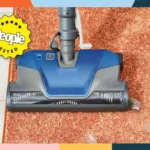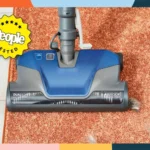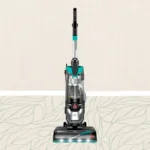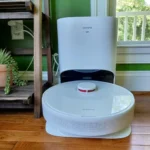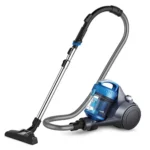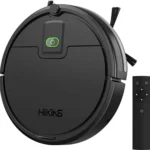Are you tired of constantly fighting pet hair and allergies in your home? It can be a frustrating battle that seems never-ending. You vacuum and clean, but the pet hair and allergens always seem to return. Fortunately, there is a solution to this problem: smart vacuum cleaners. These innovative devices are designed to work with pet owners and allergy sufferers in mind, and can help keep your home clean and healthy. In this article, we’ll explore the problem of pet hair and allergies, the importance of regular vacuuming, and how smart vacuum cleaners can solve these issues. We’ll also discuss the features and benefits of these devices and provide tips for choosing the right one for your home. So, let’s dive in and discover how smart vacuum cleaners can be the solution you’ve been looking for.
The Problem of Pet Hair and Allergies
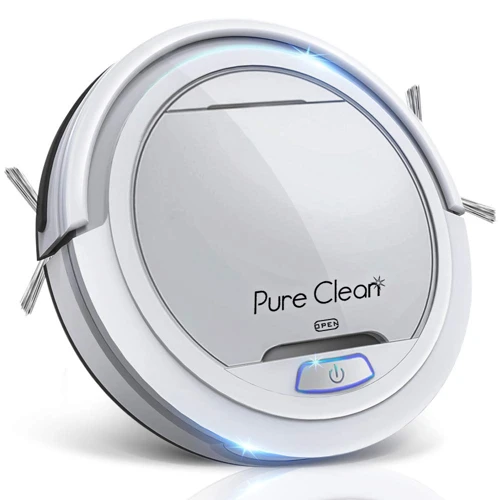
It’s no secret that cats and dogs make amazing companions, but they also bring with them a daily struggle for many pet owners: pet hair and allergies. Pet hair can get everywhere, from carpets to furniture, clothes to air ducts, causing unsightly messes, unpleasant odors, and even health issues. Allergies, in particular, can turn pet ownership from a dream to a nightmare for some people. Sneezing, itching, and congestion are just a few of the symptoms that can arise when pet dander and other particles are present in the air. But don’t give up on your furry friends just yet! With the help of smart vacuum cleaners, managing pet hair and allergies has never been easier. Let’s explore how these innovative appliances can make a real difference in your home.
What Causes Pet Allergies?
Pet allergies are a common problem among pet owners and can be caused by a number of factors. Dander, a protein found in a pet’s skin, hair, and saliva, is the most common allergen associated with pets. When a pet sheds its hair or skin, the dander becomes airborne and can cause an allergic reaction. In addition to dander, other allergens can be found in a pet’s environment, including pollen, dust, and mold, exacerbating the problem.
Allergic reactions to pets can vary in severity from mild to severe. Symptoms can include sneezing, runny nose, itchy and watery eyes, and skin rashes. In some cases, pet allergies can be life-threatening, leading to anaphylaxis, a severe allergic reaction that can cause difficulty breathing and even death.
It’s important to note that people can develop pet allergies at any age, even if they haven’t had previous exposure to pets. Additionally, some breeds of dogs and cats are less likely to cause allergic reactions than others.
While there is no cure for pet allergies, there are ways to manage symptoms and reduce exposure to allergens. Using a smart vacuum cleaner is one effective way to keep allergens under control. Want to know how it works? Check out our article on how smart vacuum cleaners save time and effort.
How Pet Hair Affects Indoor Air Quality
When people think of pet hair, they often think of the fur-covered surfaces around the home. However, a more significant concern that pet hair poses is its effect on indoor air quality. Pet hair is not just unsightly, but it is a source of allergens and other particles that can circulate within the air and cause respiratory problems. Below are some ways in which pet hair affects indoor air quality:
- Dander: Pet dander is small particles of dead skin shed by pets. It contains proteins that can trigger allergy symptoms such as sneezing, itching, and coughing.
- Dust mites: Dust mites are microscopic arachnids that feed on pet dander and thrive in humid environments. They produce allergens that can cause respiratory problems, especially in people with asthma.
- Pollen: Pets can pick up pollen from outside and bring it into the home on their fur, causing allergy symptoms in sensitive individuals.
- Bacteria and germs: Pet hair and dander can harbor bacteria and germs that can cause illness, especially in people with compromised immune systems.
The particles from pet hair can become airborne and circulate in the home’s ventilation system, worsening indoor air quality. It is crucial to take steps to reduce the amount of pet hair and dander in the home, which can be achieved by regular vacuuming. Smart vacuum cleaners are an excellent solution for pet owners and allergy sufferers who want to maintain good indoor air quality. In the next section, we will explore how smart vacuum cleaners can solve this problem and what features to look for when choosing one for your home. You can also read about the benefits of smart vacuum cleaners to get a better idea of what they can offer.
The Importance of Regular Vacuuming
Regular vacuuming is an essential part of maintaining a clean and healthy home environment, especially for pet owners and those with allergies. By getting rid of pet hair, dander, and other debris that accumulate on floors and carpets, you can reduce the amount of allergens in your home and improve indoor air quality.
However, vacuuming can be a time-consuming and laborious task, especially if you have pets that shed frequently. This is where smart vacuum cleaners come in handy. With their advanced technology and features, these robotic devices can save you time and effort while keeping your home clean and allergen-free.
In addition to removing pet hair and allergens, regular vacuuming can also help extend the life of your carpets and flooring. Dirt and debris can become embedded in carpet fibers over time, causing them to wear down and become discolored. By using a smart vacuum cleaner regularly, you can prevent this buildup and maintain the appearance of your floors.
Moreover, regular vacuuming also plays a crucial role in preventing pests such as bed bugs and fleas from infesting your home. These pests thrive in dusty, debris-filled environments, and regular vacuuming helps to eliminate the conditions that attract them.
It is recommended to vacuum high-traffic areas at least once a week and other areas, including carpets, rugs, and upholstery, at least twice a week. Additionally, it is essential to maintain your vacuum cleaner regularly, including emptying the dustbin, cleaning the filter and brush roll, and replacing the filter, if necessary.
While regular vacuuming is critical for maintaining a clean, healthy home environment, smart vacuum cleaners have revolutionized the way we clean our homes, making it more efficient, effective, and convenient. With features such as automatic charging, voice control, and mapping technology, these devices are a game-changer for pet owners and allergy sufferers.
There are various types of smart vacuums on the market, each with its unique features and benefits. To choose the right one for your needs, consider factors such as suction power, battery life, noise level, and price. To learn about the advantages of smart vacuum cleaners, click here for more information.
In the next section, we’ll discuss in more detail how smart vacuum cleaners solve the problem of pet hair and allergies. But before that, let’s look at other ways to reduce pet hair and allergens in your home.
How Smart Vacuum Cleaners Solve the Problem
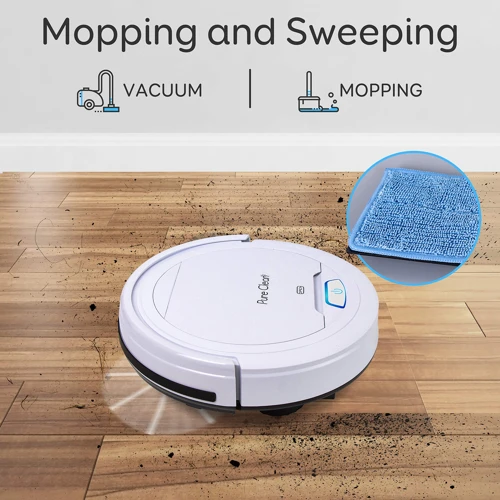
Are you tired of constantly having to vacuum up pet hair and worrying about the allergens in your home? Smart vacuum cleaners may just be the solution you’ve been looking for. With advanced features and technology, these vacuums make cleaning your home easier and more efficient than ever before. Not only do they save you time and energy, but they also provide numerous benefits for pet owners and allergy suffers. Let’s take a closer look at how smart vacuum cleaners can solve your cleaning problems. To learn more about the advantages of smart vacuum cleaners, check out this article.
Features of Smart Vacuum Cleaners
Smart vacuum cleaners are an innovative tool that can help pet owners and allergy sufferers maintain a clean and healthy home. These devices are becoming increasingly popular due to the convenience and effectiveness of their advanced features.
Here are some of the key features of smart vacuum cleaners:
| Feature | Description |
|---|---|
| Wi-Fi connectivity | Allows the vacuum cleaner to connect to your home network, enabling features such as remote control and scheduling via a smartphone app. |
| Artificial intelligence | The vacuum cleaner can learn the layout of your home and adapt its cleaning patterns accordingly. This feature also helps the device to recognize and avoid obstacles. |
| HEPA filter | The high-efficiency particulate air (HEPA) filter is designed to capture tiny particles like pet dander and dust, making the air in your home cleaner and healthier. |
| Self-charging | The vacuum cleaner docks itself in a charging station when it needs more power, making it easy to maintain a consistent cleaning schedule without human intervention. |
| Multi-surface cleaning | The vacuum cleaner can automatically adjust its suction and cleaning method based on the type of flooring or carpet in your home, ensuring a thorough and effective clean every time. |
| LED lighting | The device is equipped with LED lights that illuminate the floor, making it easier for the vacuum cleaner to detect and clean dirt and debris in dimly lit areas. |
These features make smart vacuum cleaners an effective and efficient solution for pet owners and allergy sufferers seeking to maintain a clean and healthy home. However, it’s important to note that not all smart vacuum cleaners are created equal, and buyers should consider factors such as price, brand reputation, and customer reviews before making a purchase.
If you’re interested in learning more about smart vacuum cleaners and their advanced features, be sure to check out this article on AI-powered cleaning, this guide to eco-friendly smart vacuums, and this article on using smart vacuums for home security. Additionally, if you suffer from asthma or COPD, you may be interested in reading this article on the health benefits of vacuum cleaners, and if you’re a business owner or professional cleaner, you may want to consider a smart vacuum designed for commercial use.
The Benefits of Smart Vacuum Cleaners for Pet Owners and Allergy Sufferers
Smart vacuum cleaners are a great investment for pet owners and allergy sufferers, as they provide numerous benefits in maintaining a clean and healthy indoor environment. Here are some of the benefits of using a smart vacuum cleaner:
| Benefits | Description |
|---|---|
| Efficient Cleaning | Smart vacuum cleaners can efficiently clean all types of surfaces, including carpets, hardwood floors, and tiles. They can easily pick up pet hair, dirt, and other debris, which can help reduce indoor allergens and improve air quality. |
| Convenient Scheduling | Smart vacuums can be programmed to clean on a schedule that works for you, whether you are at home or away. This means that you can ensure your home stays clean and free from pet hair and dust, without having to physically vacuum every day. |
| Advanced Features | Many smart vacuum cleaners come with advanced features, such as automated mapping and navigation, voice control, and app connectivity. These features make cleaning even easier and more efficient. |
| Reduced Allergens | By consistently vacuuming with a smart vacuum cleaner, pet owners and allergy sufferers can reduce the amount of pet hair, dander, and allergens present in their home. This can help alleviate allergy symptoms and create a more comfortable living environment. |
| Improved Air Quality | A smart vacuum cleaner not only removes visible dirt and debris from surfaces but also helps improve indoor air quality. This is especially important for allergy sufferers who may experience respiratory issues when exposed to allergens in the air. |
Investing in a smart vacuum cleaner can provide numerous benefits for pet owners and allergy sufferers, making it a worthwhile purchase for those who want to maintain a clean and healthy indoor environment.
Considerations When Choosing a Smart Vacuum Cleaner
When choosing a smart vacuum cleaner for pet hair and allergies, there are several factors to consider. Here are some important considerations to keep in mind:
| Consideration | Description |
|---|---|
| Filtration System | The filtration system is a crucial factor in a vacuum cleaner’s ability to capture allergens and pet hair. Look for vacuum cleaners with HEPA (High-Efficiency Particulate Air) filters, which can capture microscopic allergens and pet dander with greater efficiency. |
| Suction Power | The suction power is another critical factor to consider when selecting a vacuum cleaner for pet hair and allergies. High suction power ensures that the vacuum cleaner can pick up pet hair and dander from carpets, hardwood floors, and other surfaces with ease. Consider checking the vacuum cleaner’s motor power and airflow rating. |
| Noise Level | The noise level of the vacuum cleaner is important if you have pets that are sensitive to loud noises. Look for vacuum cleaners with quiet motors or have special features to reduce noise. |
| Smart Features | Smart vacuum cleaners have features like Wi-Fi connectivity, voice control, and optimized cleaning settings that make it easier to use and control. It’s important to understand which smart features are most helpful for your household. |
| Battery Life | If you’re considering a cordless smart vacuum cleaner, it’s essential to check the battery life. Choose one with a long battery life so you can finish cleaning an entire room or floor of your house without the need to recharge it multiple times. |
| Price | Smart vacuum cleaners with the latest features and technology often cost more than traditional vacuum cleaners. It’s essential to balance the features you need with the price to ensure that you’re getting the best value for your money. |
Keep in mind these considerations when choosing your smart vacuum cleaner. A quality vacuum cleaner is an investment, and selecting the right one can make a massive difference in addressing pet hair and allergy-related issues in the home.
Other Ways to Reduce Pet Hair and Allergens in Your Home
As a pet owner or allergy sufferer, it can be frustrating to feel like you’re constantly battling pet hair and allergens in your home. While smart vacuum cleaners are a great solution, there are also other steps you can take to reduce the amount of pet hair and allergens in your living space. By incorporating these additional strategies into your routine, you can create a cleaner, healthier environment for you and your family.
Groom Your Pets Regularly
Taking care of your pets is an essential part of owning one. Not only does regular grooming help maintain their appearance, but it also plays a vital role in controlling pet hair and allergies. Here are some steps you can take to groom your pets regularly and reduce the amount of pet hair and allergens in your home.
Brush Them Often: One of the simplest ways you can keep your pet’s hair under control is by brushing them regularly. Brushing helps remove loose hair and dead skin, which can often trigger allergies. Use a slicker brush or a shedding blade depending on the type of coat your pet has.
Bathe Them Regularly: Another way to control pet hair and allergies is by giving your pets a bath regularly. Use a hypoallergenic pet shampoo and conditioner to prevent any skin irritation. Regular bathing can help remove dander and other allergens trapped in their fur.
Clean Their Ears: Keeping your pet’s ears clean is also important for their overall health. Use a damp cloth or a cotton ball to clean their ears gently. Be careful not to insert anything into their ear canal, as this can cause pain and damage to their ears.
Trim Their Nails: Long nails can scratch your flooring and furniture, causing damage and leaving scratches. Keep your pet’s nails trimmed regularly to avoid this. Use a sharp nail clipper and cut just below the quick (the blood vessel inside the nail). If you’re not comfortable doing it yourself, consider taking your pet to a professional groomer.
Check for Fleas and Ticks: Fleas and ticks can cause severe allergies and transmit diseases to both pets and humans. Check your pet regularly for fleas and ticks and treat them with a flea and tick preventive medication.
By following these steps, you can reduce the amount of pet hair and allergens in your home, ultimately leading to a healthier and happier environment for both you and your pet.
Use Air Purifiers
Air purifiers are an essential tool for reducing allergies and improving air quality in your home. Airborne allergens such as pet dander, dust mites, and mold spores can cause significant health problems, especially for people with asthma or allergies. Investing in an air purifier can help you mitigate these risks and improve your overall health and well-being.
There are many types of air purifiers on the market, so it’s essential to choose one that fits your needs. Some common types of air purifiers include HEPA filters, ionizers, and electrostatic precipitators. HEPA filters are designed to capture tiny particles in the air, such as pet dander and dust mites, preventing them from being re-circulated into the air. Ionizers work by changing the electrical charge of air molecules to attract allergens and other particles, which can then be trapped by filters. Electrostactic precipitators work by creating an electric field and charging particles in the air, which then adhere to collection plates or filtered out of the air.
When selecting an air purifier, there are certain factors you should consider. The size of the unit and the area it can cover should be taken into account when considering your needs. Additionally, you should evaluate the noise level of the unit, especially if you plan on using it in your bedroom. Look for air purifiers with multiple filters or layers of protection for maximum efficiency. Lastly, consider the cost and maintenance requirements of each unit to ensure you can commit to the upkeep and prolonging the lifespan of the air purifier.
While air purifiers are a great addition to any home’s air quality control measures, it’s important to remember that they are not a replacement for regular cleaning and maintenance. Nevertheless, the use of air purifiers can significantly reduce allergens, reducing the frequency and severity of allergy and asthma symptoms.
Wash Bedding and Other Textiles Frequently
Cleaning your home is crucial when it comes to reducing pet hair and allergens. One important aspect of this is washing bedding and other textiles frequently. These textiles can easily trap pet hair, pollen, and other allergens that can cause discomfort and irritation to both pets and humans. That’s why it’s important to wash them regularly to keep them clean and free of allergens.
Here are some textiles you should wash frequently:
| Textile | Frequency |
|---|---|
| Bedding (sheets, pillowcases, blankets, etc.) | Weekly |
| Throws and pillows | Weekly |
| Area rugs | Bi-weekly or monthly |
| Curtains and drapes | Every 2-3 months |
| Upholstered furniture | Every 6 months |
If you have pets that shed a lot, it’s best to wash these textiles more frequently than the recommended schedule in order to keep allergens to a minimum. Using a vacuum cleaner with a HEPA filter on these textiles before washing can also help remove pet hair, dust, and other allergens.
When washing these textiles, it’s important to use a gentle, fragrance-free detergent and a high-temperature setting to kill dust mites and other allergens. After washing, make sure to dry them completely to prevent mold and mildew growth.
Washing bedding and other textiles frequently is a simple yet effective way to reduce pet hair and allergens in your home, and when combined with other methods like using a smart vacuum cleaner and grooming your pets, it can help create a healthier home environment for both you and your furry friends.
Keep Your Home Clean and Tidy
Maintaining a clean and tidy home is crucial for reducing the spread of pet hair and allergens. Here are some tips on how to keep your home in pristine condition:
- Regularly sweep or vacuum floors: sweep or vacuum the floors throughout your home at least once a day to keep them free from pet hair and other debris. Smart vacuum cleaners can help make this task easier and more efficient.
- Dust surfaces: dust surfaces like shelves, tables, and countertops at least once a week to remove pet hair and dander that may have accumulated there.
- Wash bedding and textiles frequently: wash your bedding, curtains, and throw pillows at least once a week in hot water to kill any dust mites or allergens that may have accumulated there.
- Clean your pet’s sleeping area: clean your pet’s sleeping area on a regular basis to remove any pet hair or dander that may have accumulated there.
- Use doormats: place doormats at all entryways to your home to reduce the amount of dirt and debris that is tracked inside.
- Limit your pet’s access: limit your pet’s access to certain areas of the home, such as bedrooms, to reduce the amount of pet hair and dander that accumulates in those areas.
By following these simple tips, you can keep your home clean and tidy, which will help reduce the amount of pet hair and allergens in the air. Remember, ensuring a clean home is just one part of a comprehensive approach to managing pet hair and allergies. Utilizing a smart vacuum cleaner, regularly grooming your pets, and using air purifiers are all other effective ways to keep your home free from pet hair and allergens.
Conclusion
In conclusion, smart vacuum cleaners have become a game changer for pet owners and allergy sufferers. The advanced technology and features make it easier than ever to maintain a clean home and reduce the amount of pet hair and allergens.
With features such as app control, scheduling, and mapping, smart vacuum cleaners can be programmed to clean your home on a regular basis, without any input from you. This not only saves time and effort but ensures that your home remains clean and healthy.
Moreover, smart vacuum cleaners are specifically designed to eliminate pet hair and allergens, which are the leading causes of indoor air pollution. By removing these particles from your home, you can breathe easier and enjoy a more comfortable living environment.
However, when selecting a smart vacuum cleaner, it is essential to consider various factors, such as performance, price, and accessories. By doing so, you can ensure that you invest in a device that meets your needs and preferences.
Additionally, there are other ways to reduce pet hair and allergens in your home, such as grooming your pets, using air purifiers, washing bedding frequently, and keeping your home clean and tidy. By combining these methods with a smart vacuum cleaner, you can significantly improve the quality of air in your home.
In short, with the advancement in technology and increasing awareness of the health hazards associated with indoor air pollution, smart vacuum cleaners have become a must-have for pet owners and allergy sufferers. By investing in a smart vacuum cleaner and following the tips mentioned above, you can enjoy a healthier and more comfortable living environment.
Frequently Asked Questions
What types of pet hair can smart vacuum cleaners handle?
Smart vacuum cleaners can handle all types of pet hair, from long and straight to short and curly. They also clean up pet dander and other allergens.
Can I schedule my smart vacuum cleaner to run when I’m not at home?
Yes, most smart vacuum cleaners have a scheduling feature that allows you to set them to clean at specific times or on certain days of the week, even when you’re not home.
Do I need to manually control my smart vacuum cleaner?
No, once you’ve set up your smart vacuum cleaner, you can control it remotely using your smartphone or other mobile device. You can start and stop the cleaner, set schedules, and adjust settings without ever touching the device.
How powerful are smart vacuum cleaners?
Smart vacuum cleaners can be just as powerful as traditional vacuum cleaners, with some models offering high suction power and advanced filtration systems to remove pet hair and allergens from your home.
Do smart vacuum cleaners work on carpet and hard floors?
Yes, most smart vacuum cleaners are designed to work on both carpet and hard floors. Some models even have sensors that detect the surface and adjust the cleaning mode accordingly.
Are smart vacuum cleaners noisy?
Most smart vacuum cleaners are designed to be quiet while in use. While they may make some noise, they are often quieter than traditional vacuum cleaners.
How does a smart vacuum cleaner navigate through my home?
Smart vacuum cleaners use sensors and mapping technology to navigate around your home. They can detect obstacles and map out the most efficient cleaning route.
What kind of maintenance do smart vacuum cleaners require?
Regular maintenance for smart vacuum cleaners includes emptying the bin, cleaning the brushroll, and replacing filters. Some models have self-cleaning features that help reduce maintenance requirements.
Can I use a smart vacuum cleaner if I have multiple pets?
Yes, smart vacuum cleaners are designed to handle multiple pets and their hair. Some models come with specialized attachments for cleaning pet hair from upholstery and other surfaces.
Are there any drawbacks to using a smart vacuum cleaner?
While smart vacuum cleaners can be effective at cleaning pet hair and allergens, they do require regular maintenance and may not work as well on very thick carpets. Additionally, some models can be expensive compared to traditional vacuums.



